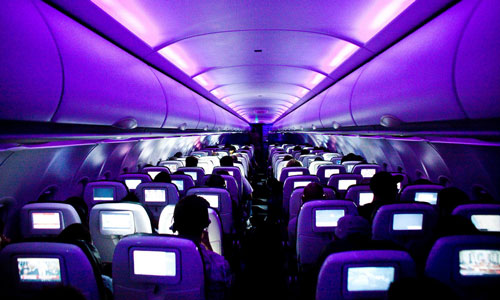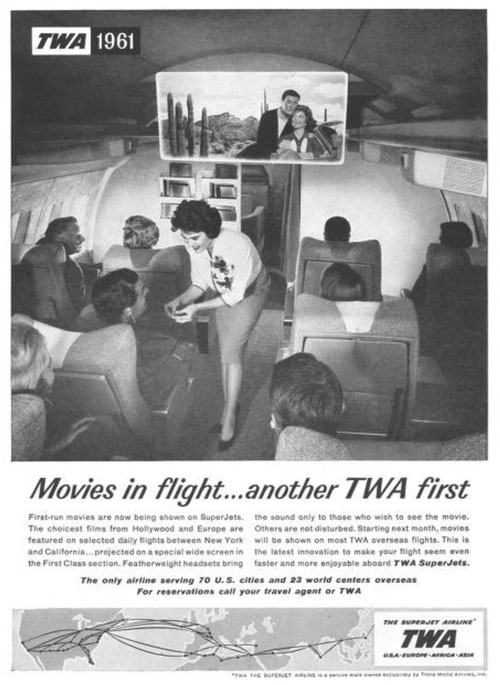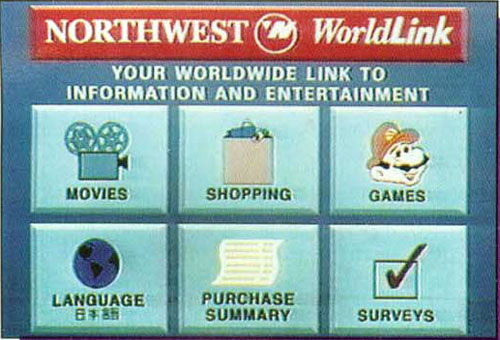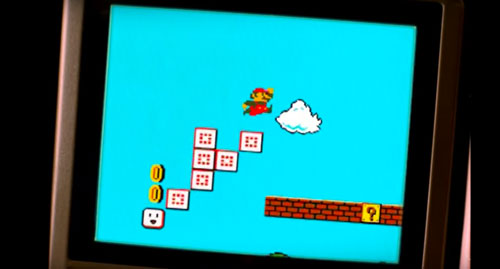Flight Risk
The in-flight entertainment system was once a novel idea that kept passengers enthralled. Now in the COVID-19 era, it’s both outdated and a serious germ hazard.
Hey all, Ernie here with an updated piece about in-fight entertainment, a concept whose potential demise has been in the news in recent weeks due to COVID-19. Updates and refreshes throughout—cheers!
Get Smarter in 5 Minutes: There’s a reason over 2 million people start their day with Morning Brew—the daily email that delivers the latest news from Wall Street to Silicon Valley. Business news doesn’t have to be dry and dense … make your mornings more enjoyable, for free.
Today’s Tedium is sponsored by Morning Brew.
1921
The year of the first claimed in-flight movie,Howdy Chicago!. The film, according to Paleofuture, was essentially a promotion for the city done for a tradeshow, and correspondingly, the plane flew over the Windy City while the film aired. The first in-flight movie that was actually a Hollywood film, according to the site, was The Lost World, which aired in 1925 on an Imperial Airlines flight.

The guy who didn’t give up on in-flight movies even when the airlines told him it was too hard
David Flexer, an entrepreneur with a focus on the silver screen, wasn’t a man afraid of a good gimmick.
In 1947, the Associated Press reported on his Memphis-area chain of drive-in theaters, because, among other things, he offered electric bottle warmers for baby’s milk.
“The mother just reaches out of her motor car, pushes a button, and an attendant brings her the bottle warmers,” Flexer told the wire service.
But his best gimmick came along in the 1960s, when he singlehandedly helped popularize the in-flight movie through his company, Inflight Motion Pictures. The problem was, it was not an easy problem to solve at first. It required a lot of research, and required airlines to add a lot of equipment in not a lot of space.
“A lot of airlines people said it couldn’t be done and wouldn’t be worth doing if it could be done,” Flexer recalled in a 1962 New Yorker article.
In an interview with the newspaper magazine Parade, Flexer (who spent much time traveling as his empire grew) explained that he had the idea while on a coast-to-coast flight.
“My basic problem was twofold: how to get lightweight equipment designed so that it could fit into the shallow compartment in the ceiling of the plane’s cabin, and how to get it so completely automated that a crew member could flick a switch and the equipment would project a two-hour movie without interruption in Cinemascope or Technicolor and then cut itself off,” Flexer recalled to Parade.
It cost him a bunch of time and money (his team went through numerous projectors that failed for one reason or another), but eventually, he found the perfect balance—a 75-pound projector, laid on its side, that accepted 16mm film—the film gauge being important because it allowed a full movie to air during a flight. The projector was designed so that it was unobtrusive and would allow flight attendants to walk through the aisle without any trouble. Audio was handled by earphones in individual seats.

An ad for in-flight movies on TWA, from a 1961 issue of Aviation Week (via the Internet Archive)
At first, he convinced one single domestic airline, TWA, to offer the service to its first-class passengers. (The first international airline to try it, Pakistan International Airlines, offered it to every passenger.) Despite the additional costs, it was such a huge success for TWA that it every other airline was suddenly interested.
“They’ve changed their tune,” Flexer said of the airlines’ early skepticism.
Soon enough, different takes on the model appeared. American Airlines, for example, introduced Astrovision, the first take on in-flight entertainment that gave passengers personalized screens—well, you had to share with your neighbor, as there was one TV for every other person, per the Chicago Tribune. It also diversified the options, giving users live television and access to multiple channels of music programs.
All these efforts, though, weren’t cheap. Adding these features to flights cost between $50,000 and $60,000 in 1965, per the Tribune. (That’s between $407,000 and $488,000 today.)
But while the model mostly worked, problems could always arise.
“A case in point is this recent incident: Tail winds so increased the speed of a New York to London jet liner that it arrived before the end of the movie,” the Tribune’s Alfred Borcover wrote.
Now, if a movie ends before the flight’s over, we just live with it.
“These TV screens, about one every six or seven rows of seats, provide much better resolution than the current video projection system. The resolution will also be better than that found on the TV sets in most American homes.”
— George Sahler, a former chairman of the World Airline Entertainment Association and an in-flight entertainment manager at Lufthansa, discussing, in a 1986 Los Angeles Times interview, the move toward multiple large screens on planes. Sahler predicted that within a decade or so that many flights would have small individual screens built into the seats, which would allow people to watch customized programming for their own personal tastes, along with live television programming beamed to the planes via satellite—two predictions that quickly became true.

The Nintendo Gateway System. (via SNES Central)
One notable in-flight entertainment system is based on the Super NES (really)
If you had a credit card and a long flight, you could play Super Nintendo games for $4 an hour on Northwest Airlines in the ’90s.
(It was certainly a bit of an upgrade for Nintendo on the aviation front. During one infamous incident in 1989, customs agents blew up an NES game, which they believed to be three sticks of dynamite.)
The Nintendo Gateway System, first introduced in 1993, wasn’t only limited to planes. It also showed up on cruise ships and in hotels—a somewhat unusual strategy for a company that at the time usually appealed to 8-year-olds. Why like this? Simply, Nintendo was looking to expand (and keep) its audience beyond 8-year-olds.
“The real problem in this business has been making the games available to kids over 18,” said Peter Main, Nintendo of America’s vice president at the time, according to a 1993 Reuters article. He added: “Now, with a with the swipe of a credit card, a guy can try a game without a snotty clerk behind the counter telling him he’s doing it wrong.”

An early variation of the Singapore Airlines Krisworld system, shown above, was likely based on the Nintendo Gateway System. (YouTube screenshot)
In other words, while other consoles were relying on realistic blood in Mortal Kombat, Nintendo was aiming for accessibility to business travelers and other old people. (This marketing strategy is something also highlighted by another Nintendo oddity of the era, the Exertainment Life Cycle.)
But while Nintendo’s approach to its Gateway System was bold, it certainly wasn’t cheap, at least in the case of the airlines. According to an article on the initiative in a 1994 issue of Nintendo Power, the company had to completely re-engineer the Super NES to fit in a tiny device roughly the size of an original Game Boy. More details:
Since space is at a premium on planes, all the components that normally fit inside your Super NES Control Deck had to be fit into a three and a half inch square that is one inch thick. To accomplish that miraculous feat, the engineers at NOA had to use many new parts. They also had to work with a different power supply that called for more efficient components. The most obvious difference between the Gateway System and the Super NES is that you can’t plug a Game Pak into the Gateway. Instead, game programs are downloaded into a two megabyte RAM (Random Access Memory.) That’s enough memory to hold the massive 16 megabit games that are becoming more commonplace.
And this thing didn’t just play video games, either—it also allowed for movies, music, phone calls, shopping, and access to information. Heck, it even allowed for faxes. (That meant the controller was more like a remote control combined with a phone, combined with a controller.) And on top of that, this multifunction monstrosity had to pass rigorous testing from regulatory bodies like the Federal Aviation Administration.
And as a result, the setup was insanely expensive. Per Nintendo Power, Northwest was spending upwards of $1.5 million per plane to get the necessary equipment installed. (It was also a moneymaker for Nintendo, which reportedly made $10 million per year in royalties on this initiative, per the New York Times.)
A clip, showing a Game Boy Color game being played on a Singapore Airlines flight.
In the case of hotels, the device was far cheaper—a much more reasonable $50 per room. And that system had much more flexibility. According to a fact sheet culled by SNES Central, the hotel version of the system eventually supported the Nintendo GameCube and Nintendo 64, whereas the airline version only supported the Super NES, Game Boy Color, and Game Boy Advance.
Nintendo often worked with different vendors on these offerings. For example, the company best-known for bringing Nintendo games to hotels, LodgeNet, was a growing force in hotel entertainment in the ’90s, and at one point, LodgeNet singlehandedly represented half a million Super NES installs.
LodgeNet has had a whole bunch of troubles since its heyday, and filed for bankruptcy in 2013. It’s now known as SONIFI Solutions.
The reason it’s struggling is the same reason that they’re talking about getting rid of seat-back monitors on planes: We have lots of other screen options these days.
“Eventually, we’ll see eye movement tracking-based user interfaces when it comes to the inflight entertainment system, so not having to touch the IFE system at all.”
— Delvin Liddell, the principal futurist for the airline industry design consultants Teague, discussing with CNN what an inflight entertainment system that doesn’t rely on touch will look like. While it’s believed at this point that touch is not the primary way that COVID-19 spreads, the risk of a highly touched object may lead to some redesigns of in-flight entertainment (as well as other parts of the air experience) in the coming years.
Even before COVID-19, additional investments in the in-flight entertainment system seemed like a bad idea, given other areas of the flying experience obviously deserved it more.
Offering basically the same service through high-speed WiFi is simply going to be cheaper, you’re cutting down on the amount of weight on the plane (which saves on jet-fuel costs), and for people who don’t have smartphones, you can make a little money simply by renting out a few tablets.
And, most notable of all, The New York Times notes that one-tenth of the cost of the average passenger plane goes to in-flight entertainment. That’s crazy! So it’s good we’re starting to lose these relics that reflect just how captive the audience is on a long flight.
And when you can bring a tablet or laptop with you, obviously the entertainment options are far more tailored on your own devices.
But the COVID-19 era turns what was before something of a bad financial investment into a true problem.
/uploads/In-Flight-Magazines.jpg)
And other forms of in-flight entertainment that don’t involve a screen are likely to suffer as well. For example, in-flight magazines have basically shut down production entirely during COVID-19—minus one case where the magazines are mailed to frequent flyers instead, a strategy that has the effect of taking away the magazine’s power of developing a captive audience. And there is no guarantee that they’ll return after the fact, as Lonely Planet notes:
Seat pockets—the home of in-flight magazines—have long been shown to harbor bugs; the industry’s budget-driven, ever tighter turnaround times has had the effect of reducing cabin cleaning to the bare minimum,” “That will change as airlines significantly step up their cleaning and disinfectant programs as flights resume, but suspicions—even fear—of any on-board surface will remain for some time.
Magazines present a particular problem in that they are touched by multiple travelers. COVID-19 research has noted the very low risk of viral transmission from paper but questions remain whether such reassurance is likely convince post-lockdown travelers to pick up a slightly dog-eared magazine whose glossy pages have been well-thumbed by any number of other people.
In many ways, the problem isn’t just the touching. It’s the perception that what was once safe is now no longer.
And then there’s the amenities question. There’s a widespread belief that COVID-19 changes could raise ticket prices higher as people stay away from the airport and some airlines block off entire seats that were once closely connected.
Given that, what would you want to see airlines invest in? Certainly, in-fight entertainment falls near the bottom of the list when not having it could potentially knock a not-insignificant price off your ticket, and you have a smartphone anyway.
Nonetheless, it’s fascinating to look back at the innovations of in-flight entertainment, which, over the span of 70 years or so, worked out so successfully that they may have innovated their way out of existence.
But seat-back Game Boys were still pretty cool when we had them.
--
Find this one an interesting read? Share it with a pal! And be sure to** check out our sponsor Morning Brew**, one of the best newsletters out there!
:format(jpeg)/2017/02/tedium022317.gif)
/2017/02/tedium022317.gif)


/uploads/ernie_crop.jpg)